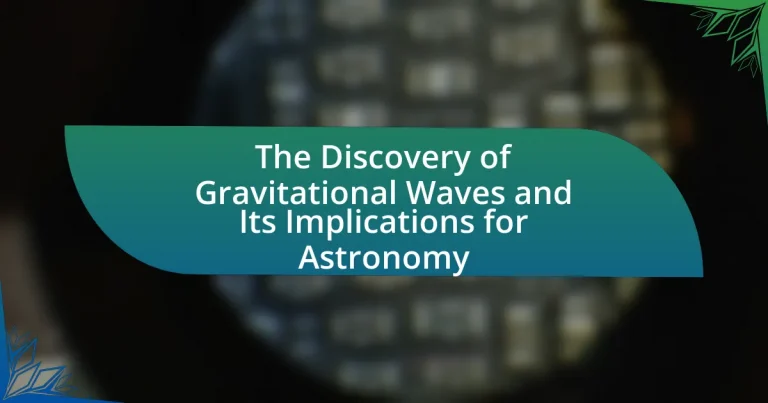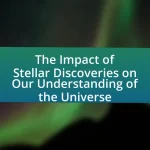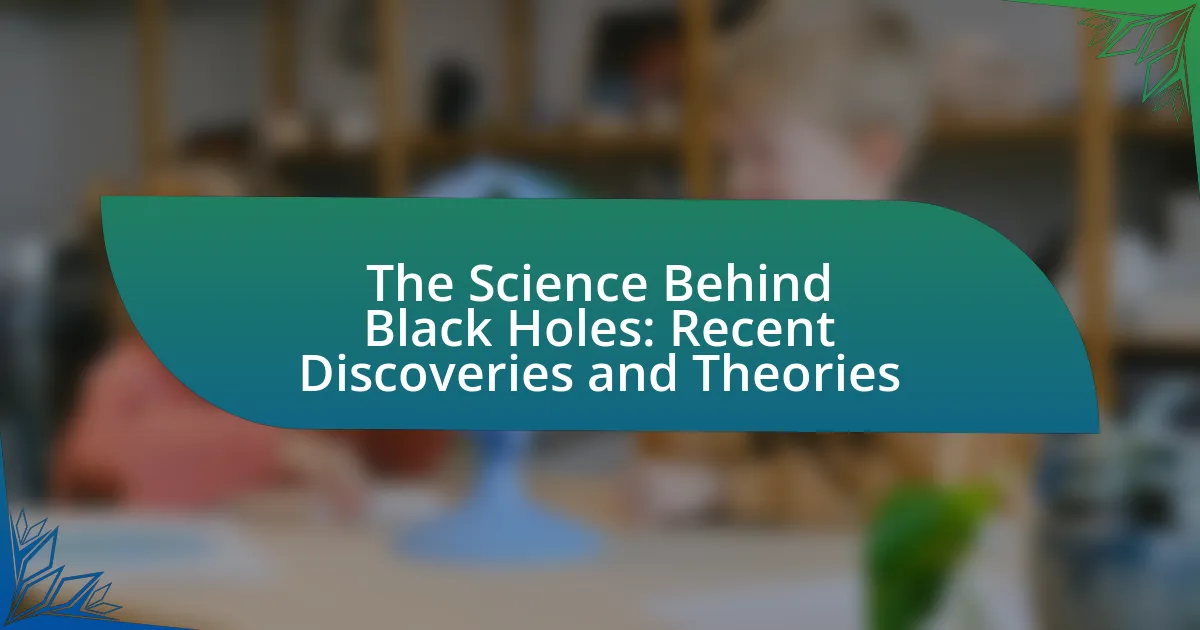Gravitational waves are ripples in spacetime produced by the acceleration of massive objects, such as merging black holes and neutron stars, first predicted by Albert Einstein in 1916. The first detection of these waves by the LIGO observatory in 2015 confirmed Einstein’s predictions and marked a significant advancement in astrophysics, enabling new methods for observing cosmic events. This article explores the characteristics of gravitational waves, the technology used for their detection, the implications of their discovery for our understanding of the universe, and the challenges and future directions in gravitational wave astronomy. Key topics include the validation of General Relativity, the impact on black hole research, and the potential for multi-messenger astronomy.
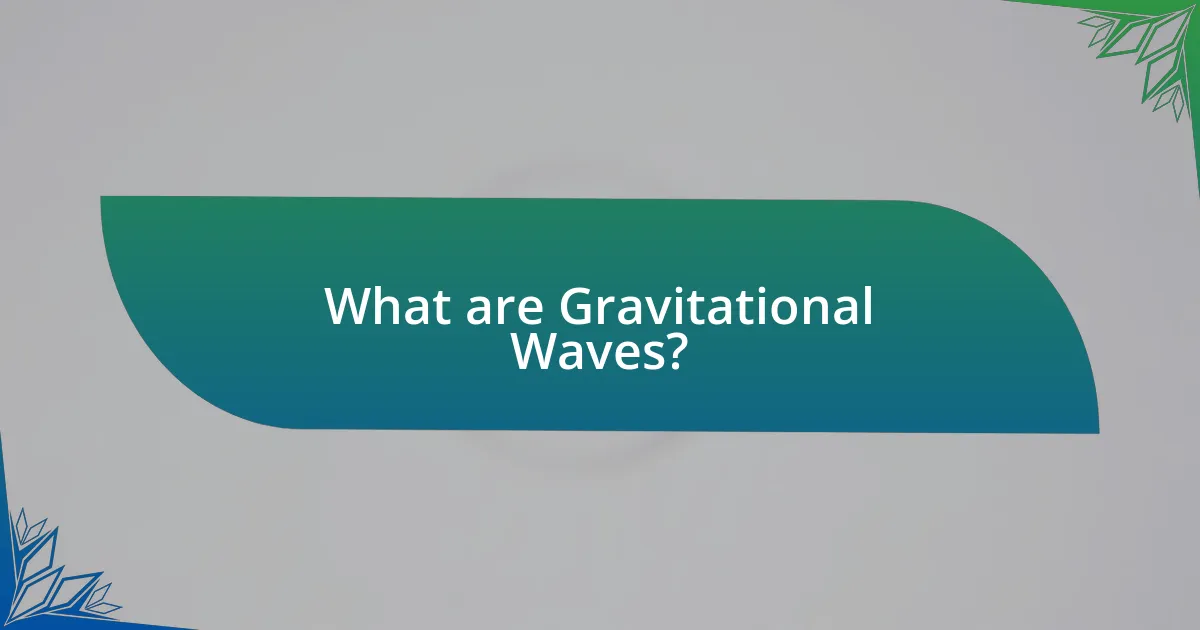
What are Gravitational Waves?
Gravitational waves are ripples in spacetime caused by the acceleration of massive objects, such as merging black holes or neutron stars. These waves propagate at the speed of light and were first predicted by Albert Einstein in 1916 as part of his general theory of relativity. The existence of gravitational waves was confirmed in 2015 by the LIGO observatory, which detected waves from a binary black hole merger, marking a significant milestone in astrophysics. This discovery has opened new avenues for observing cosmic events and understanding the universe’s fundamental properties.
How were Gravitational Waves first predicted?
Gravitational waves were first predicted by Albert Einstein in 1916 as a consequence of his General Theory of Relativity. Einstein’s equations suggested that massive objects accelerating through space would create ripples in the fabric of spacetime, which would propagate outward at the speed of light. This prediction was based on the understanding that gravity is not just a force but a curvature of spacetime caused by mass. The theoretical framework provided by Einstein laid the groundwork for future research, culminating in the direct detection of gravitational waves by the LIGO observatory in 2015, confirming his predictions nearly a century later.
What role did Einstein’s General Theory of Relativity play in this prediction?
Einstein’s General Theory of Relativity predicted the existence of gravitational waves as a consequence of the curvature of spacetime caused by massive objects. This theory, formulated in 1915, describes how gravity is not a force but a geometric property of spacetime, leading to the conclusion that accelerating masses, such as merging black holes or neutron stars, would produce ripples in spacetime. These ripples, known as gravitational waves, were confirmed by the LIGO observatory in 2015, validating Einstein’s predictions and revolutionizing our understanding of the universe.
What are the key characteristics of Gravitational Waves?
Gravitational waves are ripples in spacetime caused by accelerating masses, particularly during events like merging black holes or neutron stars. These waves travel at the speed of light and carry information about their origins, allowing scientists to study cosmic events that are otherwise invisible. They are characterized by their amplitude, which indicates the strength of the wave, and their frequency, which relates to the events that produced them. The detection of gravitational waves was first achieved by the LIGO observatory in 2015, confirming predictions made by Einstein’s General Theory of Relativity and opening a new era in astrophysics.
What methods are used to detect Gravitational Waves?
Gravitational waves are detected primarily using laser interferometry, a method exemplified by the LIGO (Laser Interferometer Gravitational-Wave Observatory) and Virgo observatories. These facilities utilize highly sensitive laser beams split into two perpendicular arms, where the interference pattern of the beams changes in response to the minute distortions in spacetime caused by passing gravitational waves. For instance, LIGO has successfully detected gravitational waves from events such as the merger of black holes, confirming the existence of these waves as predicted by Einstein’s general theory of relativity.
How does LIGO detect Gravitational Waves?
LIGO detects gravitational waves using laser interferometry, which measures tiny changes in distance caused by passing gravitational waves. The facility consists of two long arms arranged in an L-shape, each 4 kilometers in length. When a gravitational wave passes through, it stretches one arm while compressing the other, resulting in a minuscule change in length that LIGO can detect with high precision, down to a fraction of the diameter of a proton. This detection capability is validated by the successful observation of gravitational waves from events such as the merger of black holes, first confirmed on September 14, 2015, marking a significant milestone in astrophysics.
What advancements have been made in detection technology?
Recent advancements in detection technology include the development of highly sensitive interferometers, such as LIGO and Virgo, which have enabled the detection of gravitational waves. These detectors utilize laser interferometry to measure minute changes in distance caused by passing gravitational waves, achieving sensitivity levels on the order of one part in 10^21. The successful detection of gravitational waves from events like the merger of black holes has confirmed predictions made by Einstein’s General Theory of Relativity and opened new avenues for astronomical observation.
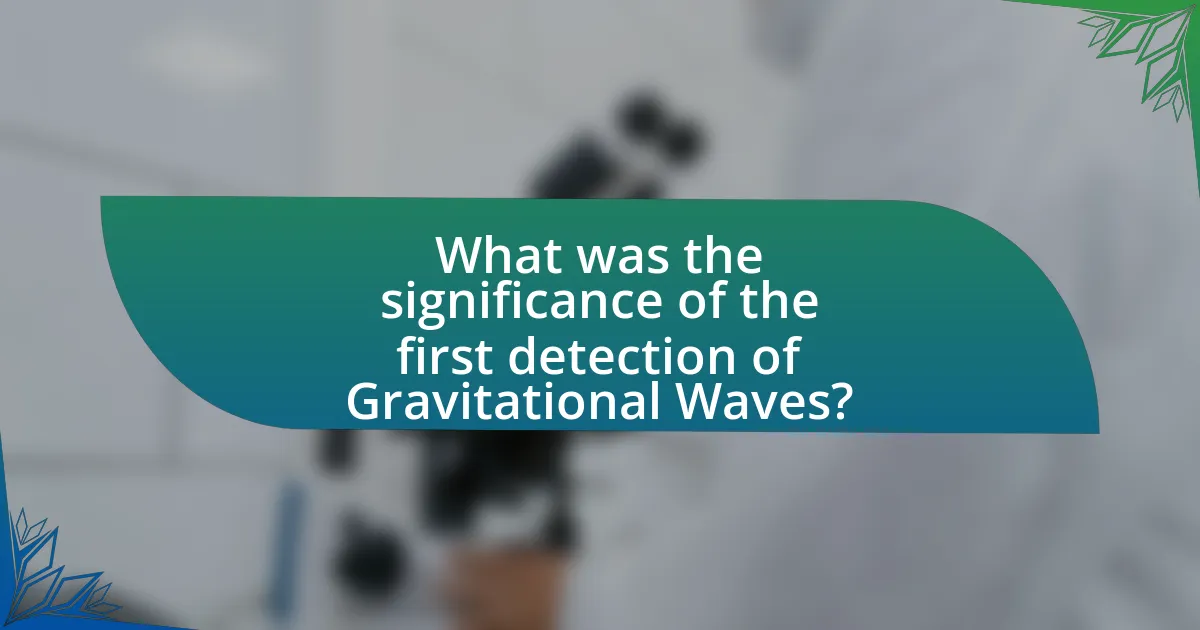
What was the significance of the first detection of Gravitational Waves?
The first detection of gravitational waves, announced on September 14, 2015, was significant because it confirmed a key prediction of Albert Einstein’s general theory of relativity and opened a new era in astrophysics. This event, resulting from the merger of two black holes, provided direct evidence of the existence of gravitational waves, which are ripples in spacetime caused by accelerating masses. The detection, made by the LIGO observatory, marked the first time that astronomers could observe cosmic events through gravitational waves, complementing traditional electromagnetic observations. This breakthrough has since enabled the study of phenomena such as black hole mergers and neutron star collisions, fundamentally enhancing our understanding of the universe and its dynamics.
How did the detection change our understanding of the universe?
The detection of gravitational waves fundamentally changed our understanding of the universe by providing direct evidence of the existence of black hole mergers and neutron star collisions. This breakthrough, achieved by the LIGO observatory in 2015, confirmed predictions made by Einstein’s general theory of relativity and opened a new era in astrophysics known as multi-messenger astronomy. The ability to observe these cosmic events through gravitational waves allows scientists to study phenomena that were previously invisible, enhancing our knowledge of the universe’s structure, the behavior of extreme matter, and the formation of heavy elements. This detection has led to a deeper understanding of the dynamics of the universe, illustrating how gravitational waves can reveal information about the most violent and energetic processes in the cosmos.
What were the implications for the study of black holes?
The discovery of gravitational waves significantly advanced the study of black holes by providing a new method to observe and understand their properties. This breakthrough allowed scientists to confirm the existence of binary black hole systems, as evidenced by the first detection of gravitational waves from merging black holes by LIGO in 2015. The data from these events enabled researchers to measure black hole masses and spins with unprecedented precision, enhancing our understanding of their formation and evolution. Furthermore, gravitational wave astronomy opened avenues for studying the dynamics of black hole mergers, contributing to the broader field of astrophysics and offering insights into the fundamental nature of gravity.
How did this detection confirm aspects of General Relativity?
The detection of gravitational waves confirmed aspects of General Relativity by providing direct evidence of the existence of ripples in spacetime caused by accelerating massive objects, such as merging black holes. This observation matched the predictions made by Albert Einstein in 1916, which stated that such waves would propagate through the universe at the speed of light. The precise measurements made by the LIGO observatory, which detected these waves, aligned with the theoretical waveforms predicted by General Relativity, demonstrating the theory’s accuracy in describing the dynamics of massive celestial events.
What were the reactions from the scientific community?
The scientific community reacted with widespread excitement and validation following the discovery of gravitational waves by LIGO in 2015. This groundbreaking finding confirmed a key prediction of Albert Einstein’s general theory of relativity, which had been proposed over a century earlier. The detection of gravitational waves provided a new method for observing cosmic events, such as black hole mergers, and opened up the field of gravitational wave astronomy. Prominent physicists, including Kip Thorne and Rainer Weiss, who were instrumental in the LIGO project, expressed that this discovery marked a monumental leap in understanding the universe. The significance of this achievement was underscored by the awarding of the Nobel Prize in Physics in 2017 to Thorne, Weiss, and Barry Barish, further solidifying the scientific community’s recognition of the importance of gravitational waves in modern astrophysics.
How did the discovery impact future research in astrophysics?
The discovery of gravitational waves significantly advanced future research in astrophysics by providing a new method for observing cosmic events. This breakthrough allowed scientists to detect and analyze phenomena such as black hole mergers and neutron star collisions, which were previously undetectable through traditional electromagnetic observations. The first detection of gravitational waves by LIGO in 2015 confirmed predictions made by Einstein’s general theory of relativity and opened a new observational window in astronomy. This has led to the establishment of multi-messenger astronomy, where gravitational wave data is combined with electromagnetic signals to gain deeper insights into the universe. The impact is evidenced by the rapid increase in research publications and collaborations focused on gravitational wave astronomy, highlighting its transformative role in understanding fundamental astrophysical processes.
What awards were given for this groundbreaking discovery?
The discovery of gravitational waves was awarded the 2017 Nobel Prize in Physics to Rainer Weiss, Barry C. Barish, and Kip S. Thorne for their decisive contributions to the LIGO detector and the observation of gravitational waves. This recognition highlights the significance of their work in confirming a key prediction of Albert Einstein’s general theory of relativity and advancing the field of astrophysics.
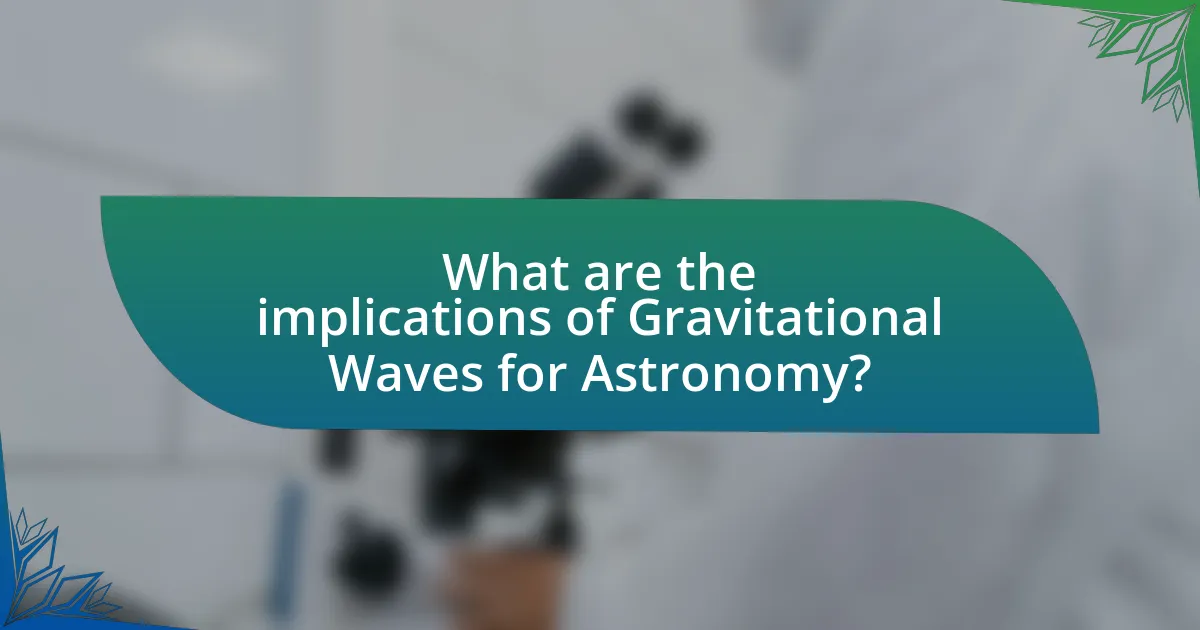
What are the implications of Gravitational Waves for Astronomy?
Gravitational waves significantly enhance astronomy by providing a new method for observing cosmic events. They allow scientists to detect and study phenomena such as black hole mergers and neutron star collisions, which are not observable through traditional electromagnetic means. The first direct detection of gravitational waves by LIGO in 2015 confirmed their existence and opened a new observational window, enabling the study of the universe’s most violent and energetic processes. This capability leads to a deeper understanding of fundamental astrophysical questions, such as the formation and evolution of black holes and the behavior of matter under extreme conditions.
How do Gravitational Waves enhance our understanding of cosmic events?
Gravitational waves enhance our understanding of cosmic events by providing a new method to observe and analyze phenomena that are otherwise invisible through traditional electromagnetic observations. These ripples in spacetime, first detected by LIGO in 2015, allow scientists to study events such as black hole mergers and neutron star collisions, which emit significant gravitational radiation but little to no light. The detection of gravitational waves from the merger of two black holes, for instance, confirmed predictions made by Einstein’s General Theory of Relativity and opened a new window into the universe, enabling the exploration of the dynamics of these extreme environments. This capability to observe the universe through gravitational waves complements existing astronomical methods, leading to a more comprehensive understanding of cosmic events and the fundamental laws of physics.
What new astronomical phenomena can be studied through Gravitational Waves?
Gravitational waves enable the study of phenomena such as black hole mergers, neutron star collisions, and the dynamics of supernovae. These waves, produced by the acceleration of massive objects, provide unique insights into events that are otherwise difficult to observe through traditional electromagnetic means. For instance, the detection of gravitational waves from the merger of two black holes by LIGO in 2015 confirmed the existence of such events and allowed for the measurement of their properties, including mass and spin. Additionally, the observation of gravitational waves from neutron star mergers has opened new avenues for understanding the formation of heavy elements in the universe, as evidenced by the simultaneous detection of electromagnetic signals from such events in 2017.
How do Gravitational Waves complement traditional electromagnetic observations?
Gravitational waves complement traditional electromagnetic observations by providing a new way to detect and study astronomical events that are otherwise invisible to electromagnetic radiation. For instance, while electromagnetic observations can reveal information about light from stars and galaxies, gravitational waves allow scientists to observe phenomena such as black hole mergers and neutron star collisions, which may not emit significant electromagnetic signals. The detection of gravitational waves from the merger of two black holes by LIGO in 2015 exemplifies this complementarity, as it provided insights into the properties of black holes that were not accessible through electromagnetic means. This dual approach enhances our understanding of the universe by allowing for a more comprehensive analysis of cosmic events.
What challenges do astronomers face in utilizing Gravitational Waves?
Astronomers face significant challenges in utilizing gravitational waves, primarily due to their weak signals and the need for highly sensitive detection equipment. The detection of gravitational waves requires advanced observatories like LIGO and Virgo, which must be capable of measuring distortions in spacetime that are smaller than a proton’s diameter. Additionally, distinguishing between noise and actual gravitational wave signals is complex, as environmental factors and instrumental noise can obscure the data. The analysis of the detected signals also demands sophisticated algorithms and computational resources to interpret the information accurately. These challenges highlight the technical and analytical hurdles that astronomers must overcome to effectively utilize gravitational waves for astronomical research.
What are the limitations of current detection methods?
Current detection methods for gravitational waves are limited by their sensitivity, frequency range, and noise levels. These methods, such as LIGO and Virgo, primarily detect waves in the frequency range of 10 Hz to a few kHz, which restricts the observation of events that emit gravitational waves at lower frequencies, such as supermassive black hole mergers. Additionally, the sensitivity of these detectors is affected by environmental noise, including seismic activity and thermal fluctuations, which can obscure signals. For instance, LIGO’s sensitivity is limited to detecting waves from events occurring within a few billion light-years, meaning many potential sources remain undetected. Furthermore, the current technology requires significant infrastructure and funding, which can limit the number of operational detectors globally.
How can future technologies improve Gravitational Wave astronomy?
Future technologies can enhance Gravitational Wave astronomy by increasing sensitivity and expanding detection capabilities. Advanced detectors, such as the proposed Einstein Telescope and Cosmic Explorer, aim to achieve a tenfold increase in sensitivity compared to current facilities like LIGO and Virgo. This improvement will enable the detection of weaker gravitational waves from more distant cosmic events, such as mergers of neutron stars and black holes. Additionally, the integration of space-based observatories, like LISA (Laser Interferometer Space Antenna), will allow for the observation of low-frequency gravitational waves, which are currently inaccessible from Earth. These advancements will significantly broaden the range of astronomical phenomena that can be studied, leading to deeper insights into the universe’s structure and evolution.
What practical steps can researchers take to advance Gravitational Wave astronomy?
Researchers can advance Gravitational Wave astronomy by enhancing detector sensitivity and expanding observational networks. Improving the sensitivity of detectors like LIGO and Virgo through technological upgrades, such as advanced laser systems and seismic isolation techniques, can increase the detection range of gravitational waves. Additionally, establishing more observatories globally, including space-based detectors like LISA, can provide a broader coverage of the sky and enable multi-messenger astronomy, allowing for the correlation of gravitational wave events with electromagnetic signals. These steps are supported by the successful upgrades implemented in LIGO, which increased its sensitivity by a factor of two, leading to the detection of more events.
